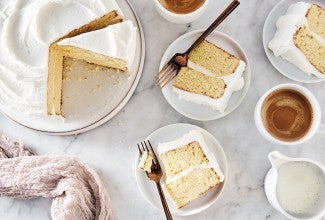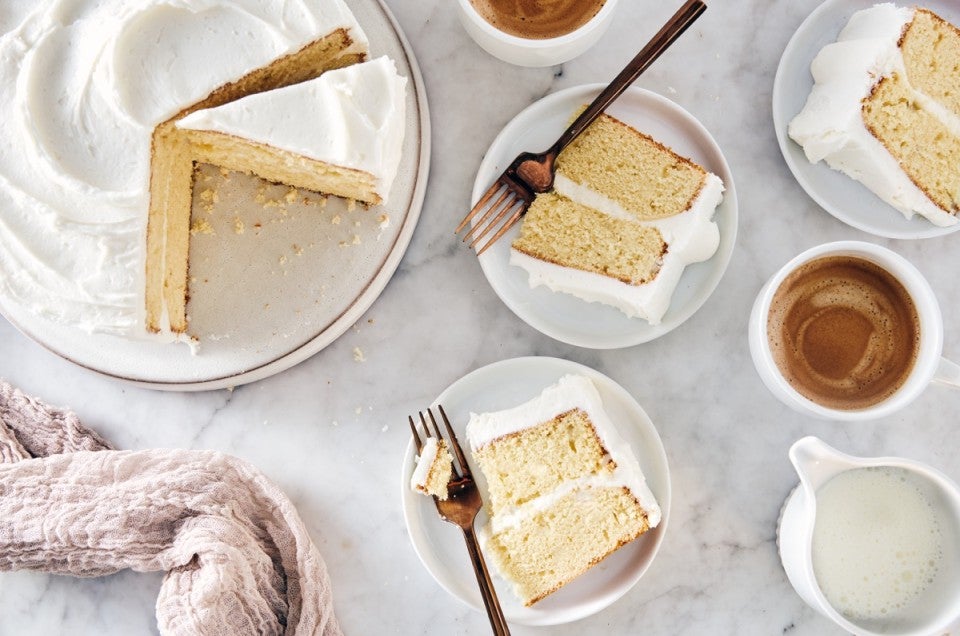


Broadly speaking, dry cake isn’t exactly an earth-shattering problem. But when you’ve put your skill, effort, and ingredients into a cake that later reveals itself to be dry — and worse yet, when that revelation comes at a special celebration — it certainly impacts your own little world.
Why does cake turn out dry — and what can you do to prevent that sawdust-y scenario? Let’s examine the most common causes of dry cake.
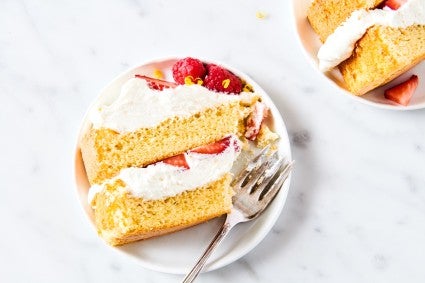
Some cakes are supposed to be a bit on the dry side: think nonfat foam cakes like angel food, or a lower-fat genoise. In fact, their drier, sturdier texture is considered an asset: They’re better able to handle being rolled or filled with custard, soaked in syrup, or slathered with whipped cream. If your recipe uses no fat or calls for butter as its only fat (and not much of it), then you can assume it’s not going to produce a super-moist cake.
Do you measure your flour with a measuring cup, or do you weigh it? If you use a cup rather than a scale there’s a good chance you’re using too much flour: up to 20% too much, if you use the measuring cup as a scoop then tamp the flour down. Any baked good — especially cake —with too much flour will be dry, hard, crumbly … take your unhappy pick. For best results, please weigh your flour (and other ingredients). Don’t have a scale? See the best way to measure flour using a measuring cup.
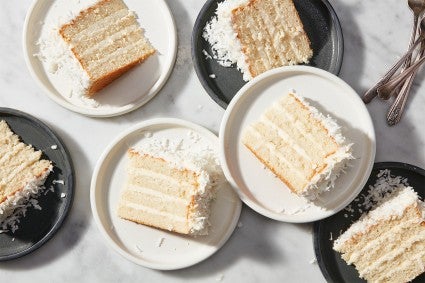
Your recipe calls for golden whole wheat flour, or cake flour, but you think “whatever” and opt for all-purpose flour. Whoops! If a recipe calls for a specific flour (and doesn’t offer a substitute), use what’s called for. Both cake flour (with its fine grind and higher starch content) and whole-grain flours (more coarsely ground) absorb and retain more liquid than all-purpose flour. This liquid retention results in a cake that stays soft and moist longer.
(So if your recipe calls for all-purpose flour, can you substitute cake or whole wheat flour and get a moister final product? Maybe. But at least on the King Arthur site, the recipes are written such that you’ll get the best results by using the flour called for.)
Butter delivers fabulous flavor — but it also contains about 20% less fat than vegetable oil. Since fat is a big contributor to a cake’s tender, soft (moist) texture, it’s best to follow the recipe as written.
If you can’t resist using butter, try substituting it for half the vegetable oil (by volume), and increasing the amount of butter you’re substituting by 25%. Example: If your recipe calls for 1/2 cup (8 tablespoons) vegetable oil, use 1/4 cup (4 tablespoons) vegetable oil and 4 tablespoons + 1 tablespoon butter. Melt the butter before stirring it into the cake batter.
Want to know more about balancing butter and oil to get the best attributes of both in your cakes? See The key to making a cake that tastes straight from the box.
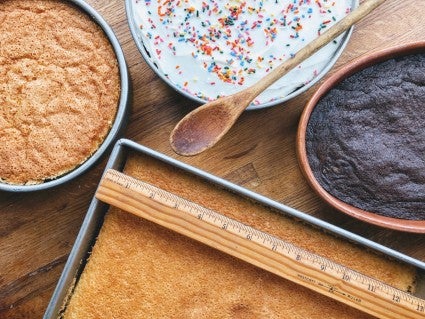
Due to their superior heat conductivity, metal pans (especially dark ones) bake much more quickly than glass or light-colored stoneware pans. So if your original cake recipe calls for a casserole dish (most often stoneware) and you substitute a metal pan, be sure to reduce the baking time to avoid overbaking (drying out) your cake. For more on the difference between metal, glass, and stoneware pans, see Glass or metal or stoneware: Which is the “right” pan?
What if your recipe calls for a 7” x 11” pan, and all you have is a 9” x 13” — close enough, right? Nope. The thinner the layer of batter the more quickly it’ll bake, and the faster the cake will dry out. Match whatever pan you have as closely as possible to what the recipe calls for, volume-wise. For help, see The essential alternative baking pan sizes.
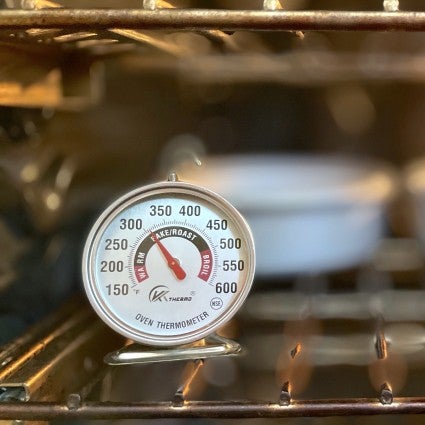
You choose your oven temperature, hit preheat, and 20 minutes later you’re sliding your cake onto the middle rack. But hold on: did you check your oven’s temperature with an independent oven thermometer?
Ovens are notorious for their inaccuracy: 10 minutes after you turn it on, the oven signals it’s 350°F when your hanging thermometer inside reads 225°F. Likewise, an oven that’s on for a while can start to creep up, the 350°F gradually becoming 375°F or even 400°F.
Baking a cake in a too-hot oven for the recommended time will dry it out. And baking a cake in a not-hot-enough oven will dry the crust before the center is fully baked. For best results, check the oven temperature before loading your cake, then monitor it every 10 minutes or so throughout the bake, making adjustments as needed.
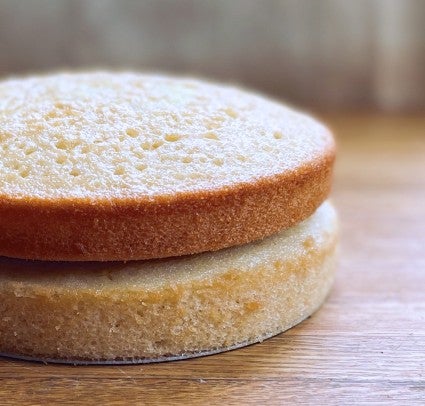
If your recipe says to bake the cake for 25 to 30 minutes, start checking it at around 20 minutes. (For what to look for, see How to tell when cake is done.) Much better to tuck your not-quite-done cake back in for 5 more minutes than to suddenly remember to look at it 10 minutes after you ignored the timer going off. Even a couple of minutes can spell the difference between a cake that’s perfectly baked and one that’s disappointingly dry.
Warning! Warning! Do NOT store cake in the refrigerator long-term unless it includes a topping or filling that needs to be refrigerated, e.g., whipped cream, custard, and their ilk. Your perfectly moist cake, no matter how well wrapped, will start to dry out after a day in the fridge.
You need to chill the cake for its filling to set? No problem. The recipe says to refrigerate the layers for 30 minutes to make them easier to frost? Fine; simply apply a crumb coat and your covered cake will remain soft for as long as 12 hours or so. But putting a perfectly good lemon cake brushed with syrup into the fridge for “safekeeping” and leaving it there for several days (or longer) is the road to ruination.
Likewise, if your cake does have to be refrigerated for a few hours (or even overnight), be sure to let it warm at room temperature for a bit before serving. Any solid fats used in the cake (e.g., butter, in either the cake itself or the frosting) re-solidify when cold, making its mouthfeel (you guessed it) dry.
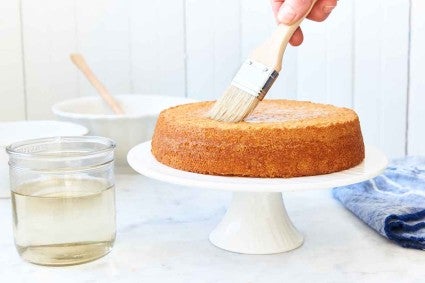
If despite your best efforts your cake turns out dry, bring it back with some simple syrup, either plain or flavored. Brushing 3 to 4 tablespoons syrup onto each layer of cake before frosting will help disguise any dryness-inducing errors you made along the way!
Does your idea of the perfect cake come right out of a box? See how to give homemade cakes that signature moist boxed-mix texture: The key to making a cake that tastes straight from the box.
Cover photo and food styling (Back-to-Basics Yellow Cake) by Liz Neily.
